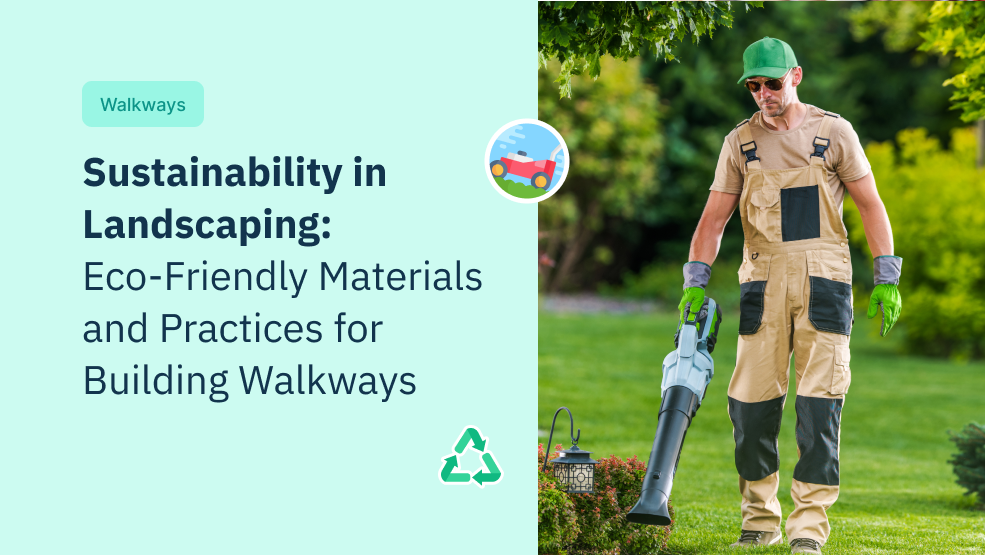When it comes to walkways, you may not know where to start. What materials can you use? How do you construct them sustainably? If you’re a landscaper, you may have known that creating sustainable walkways can be a daunting task, but with the right knowledge, you can achieve beautiful and functional landscapes while minimizing the environmental impact.
The following sections will delve into the key considerations for constructing eco-friendly walkways. We’ll explore various materials, construction methods, and maintenance practices that prioritize sustainability. By following these guidelines, you can contribute to a greener future while enhancing the aesthetic appeal of your outdoor spaces.
Not only will you be offering your clients stunning and functional walkways, but you’ll also be demonstrating your commitment to environmental responsibility. This can be a significant advantage in today’s market, as more and more people are looking for eco-conscious businesses to partner with.
Eco-friendly materials for walkways
Recycled materials
Using recycled materials like concrete, asphalt, and brick in walkway construction is an eco-friendly option. Crushed concrete and asphalt can be repurposed as aggregate for new walkways. Recycled brick can be used whole or crushed and compacted. These materials reduce waste and the need for raw materials.
Permeable pavements
Permeable pavements like porous asphalt and concrete, gravel, and pavers allow water to soak into the ground, preventing runoff. They recharge groundwater and reduce flooding. Porous asphalt and concrete contain gaps that water passes through. Gravel and pavers leave open spaces for water to infiltrate the soil underneath. Permeable pavements may require more frequent maintenance to prevent clogging. 
Locally sourced materials
Using materials sourced within a 500-mile radius reduces the carbon footprint of transportation and supports local economies. Locally quarried stone like granite, sandstone, and bluestone make attractive walkways. Salvaged materials from local demolition projects, like cobblestones, bricks, and timber, give walkways a rustic feel with low environmental impact. However, availability depends on what exists locally, and costs may be higher.
Natural stone
Materials like flagstone, slate, and fieldstone are natural, eco-friendly options for walkways. They don’t require much processing and are often sourced regionally. irregular shapes interlock well and require minimal cutting, reducing waste. tones provide an organic, natural look. However, natural stone may not be suitable or affordable for large, high-traffic walkways. And quarrying stone does require energy and impacts the local environment.
In summary, using recycled, permeable, locally sourced or natural materials, landscapers can build sustainable walkways. With some consideration of their pros and cons for each project, eco-friendly materials help minimize environmental footprint while creating functional and stylish walkways.
Best practices for building sustainable walkways
Choose Eco-friendly materials
When building walkways, choose permeable, recycled and reclaimed materials like crushed stone, brick, and reclaimed asphalt or concrete. These materials reduce waste and environmental impact. Locally sourced materials also support your community and reduce transportation emissions.
Efficient design and waste reduction
Carefully assess the site to determine the optimal path and design for your walkway. An efficient layout uses the minimum amount of materials needed. Reuse materials whenever possible and recycle waste.
Natural maintenance methods
Employ natural maintenance techniques like reseeding adjacent lawns, mulching, and hand-weeding. Avoid using chemicals, pesticides or commercial fertilizers which can run off into waterways.
Consider aesthetics and regulations
While eco-friendly walkways are ideal, also consider appearance, safety standards, and regulations. An unattractive walkway won’t be used, and one that doesn’t meet codes won’t be approved. Find a balance of form and function.
Pursue certifications
Some landscapers pursue sustainable certifications to demonstrate their commitment to eco-friendly practices. Certifications like LEED AP and Certified Green Infrastructure Professional highlight your knowledge and expertise. Certification may allow you to charge a premium and attract environmentally-conscious clients.
Building sustainable walkways requires careful planning and the right materials and techniques. By following best practices for eco-friendly construction and maintenance, landscapers can create functional, beautiful walkways with a minimal environmental footprint. Your clients and community will surely appreciate your efforts.
Additional considerations for building Eco-friendly walkways
One of the top concerns that landscapers may have when considering sustainable materials and practices is cost. While eco-friendly walkways may have higher upfront costs, their longevity and low-maintenance can save money in the long run. Many municipalities and organizations offer rebates, grants, and tax incentives for using sustainable materials and techniques. Becoming certified in sustainable landscaping through programs like LEED or the Sustainable Sites Initiative can open up access to these financial benefits.
Aesthetics
Sustainable walkways can be just as attractive as conventional ones. Using natural, reclaimed and recycled materials provides an earthy, rustic look that many homeowners appreciate. Permeable pavements like gravel, pavers, and porous asphalt also allow for vegetation in the spaces between stones or slabs, creating a softer appearance. Thoughtful design and arrangement of materials are key to an inviting space. Consider curving walkways, varied stone sizes, and companion plantings.
Regulations and certifications
Many cities and towns have regulations around permeable surfaces, runoff, and erosion control that landscapers must follow when planning walkways. Check with local municipalities for specific requirements, as well as any available incentives for eco-friendly construction. Becoming certified in sustainable landscaping and stormwater management demonstrates a commitment to best practices. Programs like LEED provide certification for individual projects, while the Sustainable Sites Initiative offers broader accreditation for landscaping companies and professionals.
Certification and compliance provide benefits beyond just abiding by regulations. They show homeowners and communities your dedication to environmental stewardship and expertise in sustainable landscaping. This can lead to more business through recommendations, referrals, and a professional reputation for eco-friendly work.
Building sustainable walkways requires consideration of material and maintenance costs, aesthetics, regulations, and certifications. However, the long-term environmental and community benefits make the investment worthwhile. By following best practices for eco-friendly construction and pursuing professional credentials, landscapers can create inviting spaces that also protect natural resources for years to come.
Final thoughts
With some thoughtful planning and the right eco-friendly materials, you can build sustainable walkways that are beautiful, functional, and gentle on the environment. Consider all the options for recycled, natural, and permeable materials that can make your projects greener. Through efficient designs, waste prevention, and natural maintenance, we can strive for a sustainable future. Just remember that small steps like using recycled bricks or low-VOC sealants can make a real difference. Our work impacts the land every day, so let’s work together to make that impact a good one. What sustainable practices will you start using on your next walkway project? Let us know in the comments.
If you’re ready to take the next step towards your landscaping business growth, here’s the solution. Give it a shot on Zuper to make your service operations seamless.






